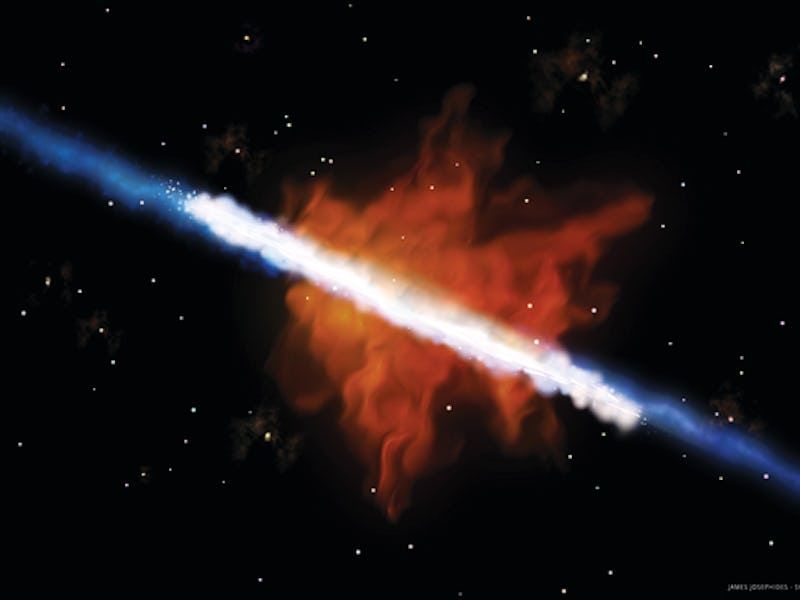Look: How the explosive death of stars pollutes the galaxy
The stinky outflow is mostly created by the explosive deaths of stars.

After years of studying how galaxies evolve over their billions of years of existence, Alex Cameron was still missing a piece of the puzzle.
Giant clouds of gas are pulled into galaxies to form their stars, and scientists have long suspected that material is eventually driven out of galaxies. But tracing how that might happen wasn’t well understood.
Until now. Cameron, a researcher from the University of Oxford, and his team recently confirmed that the gas coming out of galaxies is quite a mess. The gas is eventually pushed out through the explosive deaths of stars, known as supernovae, and ends up polluting the galaxy’s outskirts.
“Clean gas flows in, stars make it dirty, and stars dying in supernova explosions push the dirty gas out of the galaxy,” Cameron tells Inverse.
The recent findings are detailed in a study published Monday in The Astrophysical Journal.
WHAT YOU NEED TO KNOW FIRST — Galaxies are a mixture of gas, dust, matter, and stars held together through the force of gravity.
At the beginning of their lifetime, large amounts of gas are dragged into the galaxy through the pull of its gravity. Stars are born from that gas, which is mainly made up of hydrogen and helium.
After a star runs out of fuel, it ends its life dramatically through a supernova explosion. Those explosions are powerful enough to drive some of the material out of the galaxy where the stars reside.
“The elemental make-up of the inflowing and outflowing gas has long been considered an important piece of the puzzle,” Cameron says. “In the past, it has been too difficult to measure, but with modern equipment, we have now been able to measure this.”
It’s messy business, being a galaxy.
WHAT’S NEW— Using the Keck Cosmic Web Imager (KCWI) in Mauna Kea, Hawaii, Cameron and his team were finally able to measure the composition of the outflowing gas.
Each different chemical element has a specific set of colors of light, or wavelengths, that it emits which are referred to as emission lines.
“If we carefully measure the relative brightness of different emission lines from different elements like oxygen and hydrogen, this allows us to determine the chemical composition of the gas,” Cameron says.
The KCWI is able to do that in different regions of the galaxy at the same time, allowing the researchers to measure the chemical composition of the outflowing gas.
They focused on a galaxy called Mrk 1486, located around 500 million light years away from the Sun. This particular galaxy is undergoing high rates of star formation.
Gas enters the galaxy relatively unpolluted around the perimeter and condenses to form new stars. After those stars live out their lifetimes and explode, they push out other gas — which now contains heavier elements forged in the supernova explosion — through the top and bottom of the galaxy, according to the researchers.
In the video, the blue gas at the perimeter of the galaxy is the inflowing "clean" gas while the flashes of red are supernovae. Meanwhile, the red wisps are the "dirty" gas that is being pushed out of the galaxy.
In 1987, astronomers captured a supernova exploding in a nearby galaxy. This NASA visualization shows a simulation of the debris left in its wake — some of which may have pushed gas out of the galaxy.
WHY THIS MATTERS — The recent study helps astronomers understand how galaxies, including the Milky Way, formed and evolved over time.
“In the very early Universe, before the first galaxies formed, hydrogen and helium were essentially the only elements in existence,” Cameron says. “The elements that make up the rest of the periodic table have been manufactured by stars, which form within galaxies.”
As stars create these new elements, some of them can be recycled by the galaxies that host them and turned into new stars.
However, scientists were not sure how much of these elements are kept by the galaxy, and how much is expelled from the galaxy?
“We know that in the present-day Milky Way there are more of these heavier elements than there would have been in the very early Universe,” Cameron says. “Measuring the elements in the inflows and outflows of galaxies helps us to understand what might have happened during the Galaxy's history as it grew over time into the galaxy that it is today.”
Abstract: We present electron temperature (Te) maps for the edge-on system Mrk 1486, affording "direct-method" gas-phase metallicity measurements across 58 (4.1 kpc) along the minor axis and 99 (6.9 kpc) along the major axis. These maps, enabled by strong detections of the [O iii] λ4363 auroral emission line across a large spatial extent of Mrk 1486, reveal a clear negative minor-axis Te gradient in which temperature decreases with increasing distance from the disk plane. We find that the lowest metallicity spaxels lie near the extremes of the major axis, while the highest metallicity spaxels lie at large spatial offsets along the minor axis. This is consistent with a picture in which low-metallicity inflows dilute the metallicity at the edges of the major axis of the disk, while star formation drives metal-enriched outflows along the minor axis. We find that the outflow metallicity in Mrk 1486 is 0.20 dex (1.6 times) higher than the average insterstellar medium (ISM) metallicity, and more than 0.80 dex (6.3 times) higher than metal-poor inflowing gas, which we observe to be below 5% Z⊙. This is the first example of metallicity measurements made simultaneously for inflowing, outflowing, and inner disk ISM gas using consistent Te-based methodology. These measurements provide unique insight into how baryon-cycle processes contribute to the assembly of a galaxy like Mrk 1486.
This article was originally published on